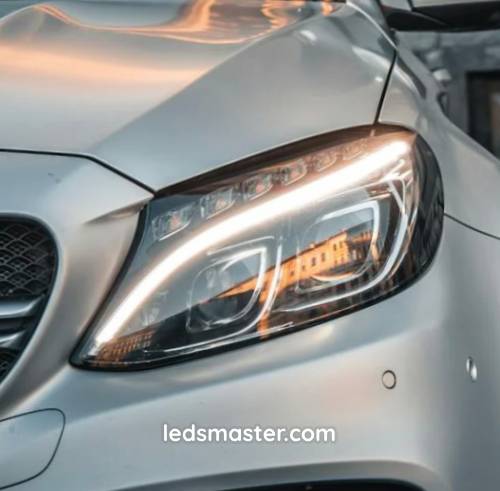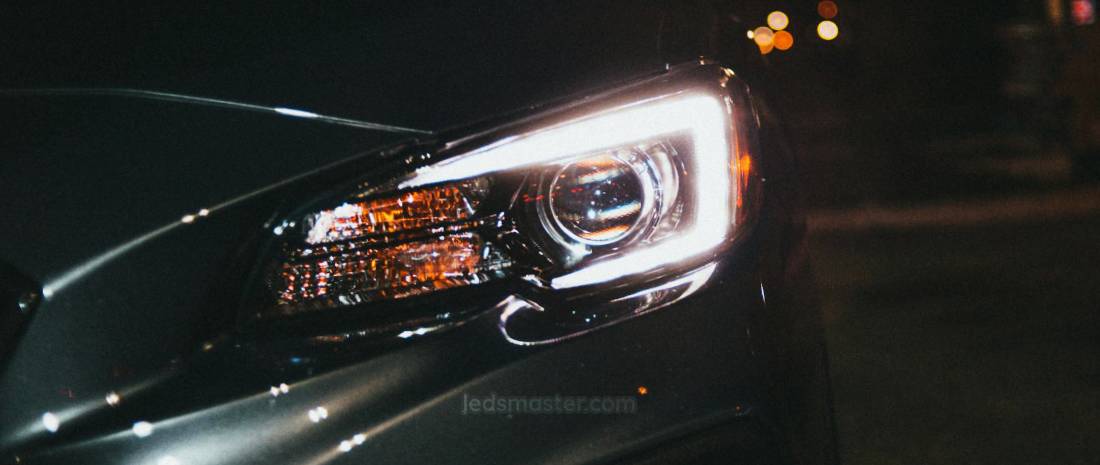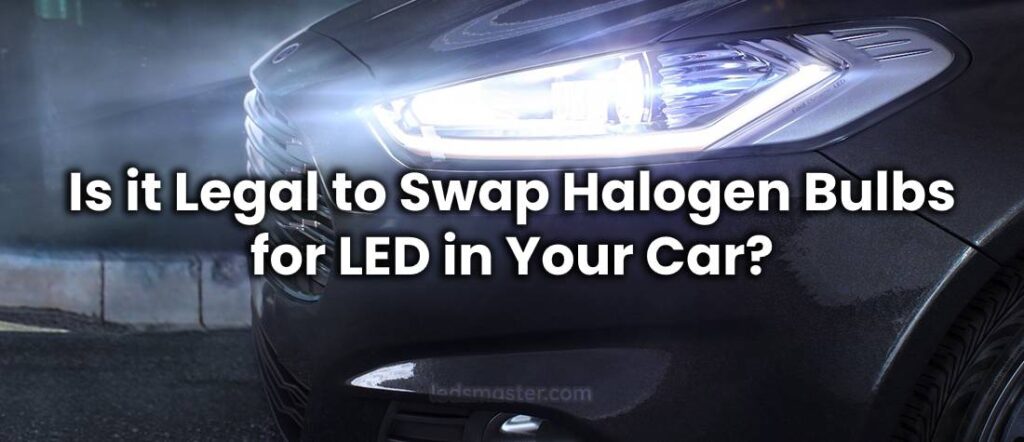Halogen bulbs are commonly used in various types of lighting systems, ranging from household fixtures to automotive applications. In recent years, there has been increasing discussion around the legality of swapping halogen bulbs for other types of bulbs, particularly in vehicles. The question arises, is it legal to swap halogen bulbs for alternatives such as LED or HID? This issue involves understanding regulations in both home lighting and vehicle lighting contexts. By exploring these regulations, benefits, drawbacks, and alternatives, a clearer picture emerges of the consequences and considerations when swapping halogen bulbs.
Table of Contents
ToggleCost of Halogen Bulbs
| Feature | Halogen Bulbs | LED Bulbs | HID Bulbs |
|---|---|---|---|
| Initial Purchase Price | Low | Higher | Higher |
| Lifespan | 1,000 – 2,000 hours | 15,000 – 25,000 hours | 2,000 – 3,000 hours |
| Energy Consumption | High (more power needed) | Low (energy-efficient) | Moderate (energy-efficient but higher than LED) |
| Replacement Frequency | High (frequent replacement) | Low (rare replacement) | Moderate (moderate replacement) |
| Operating Cost (Annual) | High (due to high energy consumption) | Low (lower electricity bills) | Moderate (better than halogen, but more than LED) |
| Cost per Unit Replacement | Low | Moderate to High | Moderate to High |
| Long-Term Cost Efficiency | Low (due to frequent replacements and high energy usage) | High (long lifespan and low energy consumption) | Moderate (higher than LED due to bulb cost but lower than halogen in operating cost) |
Initial Purchase Price
 Halogen bulbs are generally one of the most affordable lighting options on the market. The upfront cost of a halogen bulb is relatively low compared to other lighting alternatives, such as LEDs or HID bulbs. This makes halogen bulbs an attractive option for those looking for a budget-friendly lighting solution. For household use, halogen bulbs are readily available in various sizes and wattages, and their price often reflects their widespread availability and simple technology.For automotive use, halogen bulbs are also the standard and the most cost-effective choice. They can be found in a wide range of vehicle models and typically cost less than alternative lighting systems like HID or LED headlights. The price of halogen bulbs in vehicles is generally affordable, and replacements can often be done without significant investment.
Halogen bulbs are generally one of the most affordable lighting options on the market. The upfront cost of a halogen bulb is relatively low compared to other lighting alternatives, such as LEDs or HID bulbs. This makes halogen bulbs an attractive option for those looking for a budget-friendly lighting solution. For household use, halogen bulbs are readily available in various sizes and wattages, and their price often reflects their widespread availability and simple technology.For automotive use, halogen bulbs are also the standard and the most cost-effective choice. They can be found in a wide range of vehicle models and typically cost less than alternative lighting systems like HID or LED headlights. The price of halogen bulbs in vehicles is generally affordable, and replacements can often be done without significant investment.
Operating Costs
While the initial cost of halogen bulbs is low, they tend to have higher operating costs compared to alternatives. Halogen bulbs are less energy-efficient than LEDs and other modern lighting technologies, meaning they require more electricity to produce the same amount of light. This increased energy consumption leads to higher electricity bills, particularly in households or businesses with many lights in use.For automotive applications, halogen bulbs also consume more power than LEDs or HID lights, which can place a higher load on the vehicle’s electrical system. This added power demand could slightly affect fuel efficiency, especially in vehicles with older electrical systems. While the cost of electricity for a halogen bulb may seem small in isolation, over time it can accumulate, making the switch to more energy-efficient options a cost-saving choice.
Maintenance and Replacement Costs
Halogen bulbs have a relatively short lifespan compared to other types of bulbs, typically lasting around 1,000 to 2,000 hours. As a result, they need to be replaced more frequently than LEDs or CFLs, which can last much longer. The need for frequent replacements increases the long-term costs of halogen bulbs.For home lighting, replacing halogen bulbs multiple times a year can add up, particularly if they are used in high-traffic areas or continuously operated fixtures. In vehicles, while the initial cost of halogen bulbs is low, drivers may find themselves needing to replace the bulbs more often, especially if the vehicle’s headlamps are exposed to harsh weather conditions or frequent usage. Frequent replacements can contribute to the overall maintenance costs of a vehicle.
Long-Term Cost Comparison with Alternatives
When comparing the long-term costs of halogen bulbs to more energy-efficient alternatives like LEDs, the gap becomes clearer. While LEDs and other modern lighting systems may have a higher upfront cost, their significantly longer lifespan and lower energy consumption mean that they offer considerable savings over time. For instance, an LED bulb can last up to 25,000 hours, far surpassing the 2,000-hour lifespan of a halogen bulb, and uses much less power to produce the same light output.In automotive lighting, switching from halogen bulbs to LEDs or HID bulbs may involve higher initial installation costs, but these systems last longer and consume less power, making them a more economical option in the long run. With the increasing affordability of LED and HID bulbs, many vehicle owners are opting to replace their halogen headlamps, seeing substantial savings on both energy consumption and maintenance costs over the vehicle’s lifespan.While the initial cost of halogen bulbs is appealing, their higher operating and replacement costs over time make them a less economical choice when compared to alternatives such as LEDs or CFLs. The long-term cost benefits of energy-efficient lighting are an important consideration when deciding whether to stick with halogen bulbs or explore newer options.

Legality of Swapping Halogen Bulbs
Home Lighting Context
In the home lighting sector, swapping halogen bulbs for other types of bulbs such as LEDs or compact fluorescent lamps (CFLs) is not subject to strict regulations. Consumers have the freedom to replace halogen bulbs with more energy-efficient alternatives without violating any laws. While there are energy efficiency standards and regulations that apply to the manufacturing and sale of light bulbs, these are not necessarily prohibitive when it comes to replacing bulbs in existing fixtures. Individuals looking to swap halogen bulbs with other types of lighting generally do not face legal restrictions as long as the new bulbs are compatible with the fixture and the local electrical code is adhered to.
Vehicle Lighting Context
When it comes to vehicle lighting, the situation becomes more complex. Vehicle lighting is subject to stricter regulations in most countries, with rules enforced by road safety authorities. Swapping halogen bulbs for other lighting types such as LED or HID can sometimes fall under scrutiny, particularly when it involves modifications to the vehicle’s headlamp system.In certain jurisdictions, changing halogen bulbs for non-approved lighting options may violate road safety laws. Vehicle manufacturers design headlamp systems with specific types of bulbs in mind, and using a different type of bulb could potentially affect the performance of the vehicle’s lighting system, including brightness and alignment. These factors could impair the driver’s visibility and the vehicle’s visibility to other road users, which is a primary safety concern. Moreover, some vehicle modifications, such as installing unauthorized LED or HID bulbs, may lead to the vehicle failing inspection, resulting in fines or the requirement to revert the system to its original form.
Benefits of Swapping Halogen Bulbs
Energy Efficiency
One of the main reasons people choose to swap halogen bulbs is the potential for increased energy efficiency. Halogen bulbs are less energy-efficient than alternatives such as LED or CFL bulbs. LEDs, in particular, consume a fraction of the energy that halogen bulbs use to produce the same amount of light. This energy efficiency leads to lower electricity bills, making it a financially sound decision for homeowners looking to reduce their power consumption.Furthermore, because LEDs and other energy-efficient lighting options generate less heat than halogen bulbs, there is also a reduction in cooling costs during the warmer months. This benefit is particularly valuable in climates where air conditioning is used frequently.
Longer Lifespan
Another significant advantage of swapping halogen bulbs is the extended lifespan of modern alternatives. Halogen bulbs typically last around 2,000 hours, whereas LEDs can last up to 25,000 hours or more. This long lifespan means fewer replacements, reducing the overall cost of purchasing new bulbs over time. It also contributes to less waste, as fewer bulbs end up in landfills.In the context of vehicle lighting, switching to LED or HID bulbs can result in fewer replacements and greater reliability. Drivers can rely on these lighting options to provide consistent illumination over a much longer period, reducing the hassle and cost associated with frequently changing automotive bulbs.
Reduced Environmental Impact
Swapping halogen bulbs for more energy-efficient lighting can also have positive environmental effects. As energy use decreases, so does the demand for power from non-renewable sources. Reducing energy consumption helps lower the carbon footprint of individuals and households. In addition, many LEDs and CFLs are made from more environmentally friendly materials and contain fewer hazardous substances, like mercury, compared to older incandescent or halogen bulbs.In the automotive sector, making the switch to LED or HID headlights can reduce the environmental impact of driving by improving fuel efficiency. Since these bulbs draw less power from the vehicle’s electrical system, the alternator doesn’t need to work as hard, potentially improving fuel economy over time.
Drawbacks and Dangers of Swapping Halogen Bulbs
Compatibility Issues
One of the primary challenges when swapping halogen bulbs is ensuring compatibility with existing fixtures or systems. For home lighting, replacing halogen bulbs with LEDs or CFLs typically doesn’t pose many issues, as long as the wattage and socket type match. However, the fixture or circuit might not always be optimized for newer technologies, which could lead to performance issues. For example, an incompatible LED bulb may flicker or fail to light up entirely.In vehicles, the compatibility issues can be more complex. Not all vehicles are designed to handle LED or HID bulbs in place of halogen bulbs, and modifications to the headlamp system may require additional components or adjustments. These changes could affect the functioning of the vehicle’s electrical system and could lead to problems such as flickering, overheating, or improper alignment of the headlights.
Safety Concerns
When swapping halogen bulbs in vehicles, there are significant safety concerns to consider. Not all LED or HID bulbs are designed with road safety in mind. Some aftermarket bulbs may emit light in a way that causes glare or reduces visibility, particularly if the alignment is incorrect. These issues can create hazardous driving conditions, as improper headlights can blind other drivers or fail to illuminate the road adequately. Additionally, poorly installed or substandard bulbs may fail to meet road safety standards, potentially resulting in fines or penalties.In terms of home lighting, while energy-efficient bulbs tend to be safer in general, low-quality LED or CFL bulbs can pose risks. Poorly manufactured bulbs may overheat, increasing the risk of electrical fires. Choosing reputable brands and ensuring that bulbs are certified for use in your country is important to minimize these risks.
Regulatory and Warranty Concerns
When swapping halogen bulbs in vehicles, it’s also important to consider potential warranty issues. If a vehicle is still under warranty, modifying the lighting system could void that warranty. Manufacturers may stipulate that any non-approved modifications can result in the denial of claims related to the vehicle’s electrical system or lighting components.Moreover, if the modified vehicle fails a safety inspection due to illegal bulbs or improper installation, the driver may be required to revert to the original halogen bulbs. This process can be time-consuming and costly, especially if the modification was done without considering legal or regulatory frameworks.
Alternatives to Halogen Bulbs
LED Bulbs
LED bulbs are perhaps the most popular alternative to halogen bulbs. Known for their energy efficiency, longevity, and brighter light output, LEDs are a clear choice for many who want to reduce energy costs and environmental impact. In home lighting, LEDs can be used to replace halogen bulbs in most fixtures, and they come in a variety of color temperatures and brightness levels to suit different needs.For automotive lighting, LED bulbs are increasingly being used to replace halogen bulbs. They offer brighter illumination and a whiter light, improving visibility and aesthetics. However, it’s important to ensure that the vehicle’s electrical system can accommodate the change, as improper installation could result in issues.
HID Bulbs
HID (High-Intensity Discharge) bulbs are another alternative that offers a significant improvement in lighting performance compared to halogen bulbs. These bulbs are often used in high-end vehicles and offer a bright, focused light that provides superior road visibility. HID bulbs consume less energy than halogen bulbs and have a longer lifespan. However, like LEDs, HID bulbs can also cause compatibility issues if not installed properly.HID lighting systems often require additional components, such as ballast and wiring, to operate correctly, which can increase the cost of the installation process. Additionally, HID lights are not as widely accepted in all jurisdictions due to concerns about their impact on road safety and their potential to cause glare for other drivers.
CFL Bulbs
CFL bulbs, or compact fluorescent lamps, are another option that can replace halogen bulbs in home lighting systems. While they are less efficient than LEDs, they are still more energy-efficient than halogen bulbs. CFLs also tend to last longer than halogen bulbs, providing a good balance between cost and efficiency. However, CFLs contain small amounts of mercury, which makes their disposal more complicated compared to other lighting options.
Considerations When Swapping Halogen Bulbs
Benefits of Swapping Halogen Bulbs
Swapping halogen bulbs can lead to lower energy consumption, cost savings, and reduced environmental impact. LED and HID bulbs, in particular, use less power and last longer, helping to decrease operating costs and minimize the need for frequent replacements.
Compatibility Considerations
Compatibility is important when replacing halogen bulbs. In homes, ensure the new bulbs fit the fixture and match in wattage. For vehicles, swapping to LED or HID bulbs may require additional components and modifications to ensure proper performance.
Safety Concerns
Proper installation is vital for safety. Incorrectly installed or low-quality bulbs can cause hazards, such as overheating or poor illumination. In vehicles, improper lighting can result in glare or reduced visibility, posing risks on the road.
Legal and Regulatory Considerations
Check local regulations before swapping halogen bulbs, especially in vehicles. Certain modifications may violate road safety laws or result in failed vehicle inspections. Ensuring compliance with local codes is essential.
Choosing the Right Alternative
Selecting between LED, HID, or CFL bulbs depends on your needs. LEDs are ideal for both home and automotive use due to their energy efficiency, while HID bulbs provide bright, focused light for vehicles, and CFLs are a good alternative for home lighting.
Importance of Proper Installation
Proper installation ensures the new bulbs function safely and efficiently. In both homes and vehicles, follow manufacturer guidelines or seek professional assistance to avoid potential issues.
Conclusion
Swapping halogen bulbs for alternative lighting options, such as LED or HID bulbs, presents both benefits and challenges. While halogen bulbs are affordable initially, their higher operating costs and frequent replacement needs make them less economical in the long run. Switching to energy-efficient alternatives can provide substantial savings in both energy consumption and maintenance costs, while also reducing environmental impact. However, the legality of making such changes, particularly in vehicle lighting, depends on local regulations, which often place restrictions on modifications to ensure road safety.

